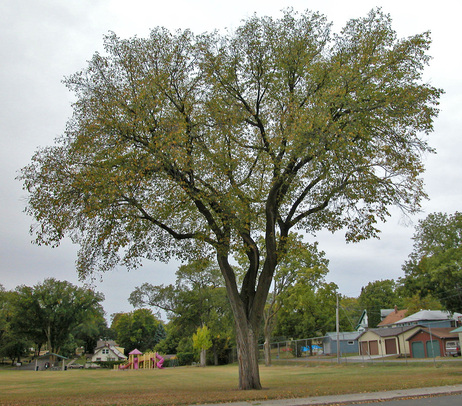|
I find myself in many conversations involving the use of exotic woods. At times it seems as though I'm in a "Who can Stump the Wood Guy" competition. Having worked with wood for my entire career and holding a degree involving wood technology I guess I should be aware of more exotic woods than most. However there are in fact many, many more wood species that I am not familiar with nor ever will be. And that's OK with me. Exotic woods by definition are "...of foreign origin or character; not native; introduced from abroad..." The truth be told I have never been the least bit interested in using materials that are not native to where I live and work. Having said that, I must remind you that all the beautiful woods I gather locally are indeed considered "Exotic" everywhere else in the world, so I suppose when viewed from a global perspective I do indeed work with exotics. I'd like to introduce you to three of my favorite Otter Tail County Exotics:  American Elm Ulmus americana This is one of the few woods I use that also has value as a furniture wood or for commercial lumber. I like the strength of the grain pattern. It's strong but not overpowering. Of particular interest is the fine wavy pattern in the summer growth (space between the rings). This herringbone pattern makes this specie shimmer.  The broad, uniform canopy has made the American Elm a favorite urban tree valued for its shade in yards and parks.  The American Elm has been a favorite for lining boulevards. These Elm tree-lined streets are fast becoming a thing of the past as Dutch Elm Disease (named for where the disease was first located not the specie) continues to decimate the Elm population.  Cottonwood Populus deltoides Cottonwood has very little commercial value due to its low strength, density, and tensile attributes. It's often used for low value items such as pallets and lath. It is one of my favorites. The flame grain that I find in the cottonwood takes my breath away.  An incredibly graceful tree, I have measured local specimens with 6' diameters. The slightest breeze will produce a beautiful rustling sound as the thin, flat-stemmed leaves flutter.  Boxelder Acer negundo Boxelder is a real show stopper. The vibrant dashes of red overlaid on the satiny grain of the Maple is striking indeed. In the rare cases where I carve a piece with no red present the result is almost as though it was made of ivory.  The red in the boxelder is present as the tree grows. This is a picture of a freshly cut boxelder log. What causes the red will be the topic of a future blog. Hint: Boxelder beetles are non-boring beetles.  I have to say that I prefer knowing where my material comes from. Best wishes - Jay from the very Exotic Otter Tail County
2 Comments
|
About Me:
I'm a contemporary wood sculptor living and working in rural Minnesota. I gather my logs locally and travel the country selling what I make from them. Archives
October 2023
Categories
All
|

